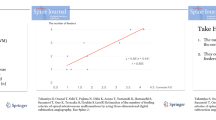Abstract
Background and Purpose
Endovascular trapping of the vertebral artery dissecting aneurysms (VADAs) carries a risk of medullary infarction due to the occlusion of the perforating arteries. We evaluated the detectability and anatomical variations of perforating arteries arising from the vertebral artery (VA) using three-dimensional DSA.
Methods
In 120 patients without VA lesions who underwent rotational vertebral arteriography, the anatomical configurations of perforating arteries from the VA were retrospectively evaluated on the bi-plane DSA and reconstructed images to reach the consensus between two experienced reviewers. The images were interpreted by focusing on the numbers and types of perforating arteries, the relationships between the number of perforators and the anatomy of the VA and its branches.
Results
Zero, 1, 2, 3, 4, and 6 perforators were detected in 2, 51, 56, 9, 1, and 1 patient, respectively (median of 2 perforators per VA). The 200 perforators were classified into 146 terminal and 54 longitudinal course types and into 32 ventral, 151 lateral, and 17 dorsolateral distribution types. All ventral type perforators were also terminal type. In contrast, the longitudinal type was seen in 28.5% of lateral types and in 65% of dorsolateral types. Regarding the difference in the origin of the posterior inferior cerebellar artery (PICA), non-PICA type VAs gave off larger number of perforators than the other types of VAs.
Conclusions
Non-PICA type VAs give off a significantly larger number of perforators than other types, indicating that the trapping of non-PICA type VAs is associated with a risk of ischemic complications.






Similar content being viewed by others
References
Arnold M, Bousser MG, Fahrni G, Fischer U, Georgiadis D, Gandjour J, Enninger D, Sturzenegger M, Mattle HP, Baumgartneret RW (2006) Vertebral artery dissection: presenting findings and predictors of outcome. Stroke 37:2499–2503
Mizutani T, Aruga T, Kirino T, Miki Y, Saito I, Tsuchida T (1995) Recurrent subarachnoid hemorrhage from untreated ruptured vertebrobasilar dissecting aneurysms. Neurosurgery 36:905–911
Yamada M, Kitahara T, Kurata A, Fujii K, Miyasaka Y (2004) Intracranial vertebral artery dissection with subarachnoid hemorrhage: clinical characteristics and outcomes in conservatively treated patients. J Neurosurg 101:25–30
Kurata A, Ohmomo T, Miyasaka Y, Fujii K, Kan S, Kitahara T (2001) Coil embolization for the treatment of ruptured dissecting vertebral aneurysms. AJNR Am J Neuroradiol 22:11–18
Kurata A, Yamada M, Ohmomo T, Hirayama H, Suzuki S, Miyasaka Y, Irikura K, Fujii K, Kitahara T (2001) The efficacy of coil embolization at the dissection site of ruptured dissecting vertebral aneurysms. Interv Neuroradiol 7:73–82
Endo H, Matsumoto Y, Kondo R, Sato K, Fujimura M, Inoue T, Shimiuz H, Takahashi A, Tominaga T (2013) Medullary infarction as a poor prognostic factor after internal coil trapping of a ruptured vertebral artery dissection. J Neurosurg 118:131–139
Hamada J, Kai Y, Morioka M, Yano S, Todaka T, Ushio Y (2003) Multimodal treatment of ruptured dissecting aneurysms of the vertebral artery during the acute stage. J Neurosurg 99:960–966
Aihara M, Naito I, Shimizu T, Matsumoto M, Asakura K, Miyamoto N, Toshimoto Y (2018) Predictive factors of medullary infarction after endovascular internal trapping using coils for vertebral artery dissecting aneurysms. J Neurosurg 129:107–113
Ikeda H, Imamura H, Mineharu Y, Tani S, Adachi H, Sakai C, Ishikawa T, Asai K, Sakai N (2016) Effect of coil packing proximal to the dilated segment on postoperative medullary infarction and prognosis following internal trapping for ruptured vertebral artery dissection. Interv Neuroradiol 22:67–75
Lescher S, Zimmermann M, Konczalla J, Deller T, Porto L, Seifert V, Berkefeld J (2016) Evaluation of the perforators of the anterior communicating artery (AComA) using routine cerebral 3D rotational angiography. J Neurointerv Surg 8:1061–1066
Lescher S, Samaan T, Berkefeld J (2014) Evaluation of the pontine perforators of the basilar artery using digital subtraction angiography in high resolution and 3D rotation technique. AJNR Am J Neuroradiol 35:1942–1947
Antunović V, Mirčić A, Marinković S, Brigante L, Mališ M, Georgievski B, Aksić M (2017) Clinical significance of the cerebral perforating arteries. Pril (Makedon Akad Nauk Umet Odd Med Nauki) 38:19–29
Marinković S, Milisavljević M, Gibo H, Maliković A, Djulejić V (2014) Microsurgical anatomy of the perforating branches of the vertebral artery. Surg Neurol 61:190–197
Djulejić V, Marinković S, Milić V, Georgievski B, Rašić M, Aksić M, Puškaš L (2015) Common features of the cerebral perforating arteries and their clinical significance. Acta Neurochir 157:743–754
Iwai T, Naito I, Shimaguchi H, Suzuki T, Tomizawa S (2000) Angiographic findings and clinical significance of the anterior and posterior spinal arteries in therapeutic parent artery occlusion for vertebral artery aneurysms. Interv Neuroradiol 6:299–309
Kudo T, Iihara K, Satow T, Murao K, Miyamoto S (2007) Incidence of ischemic complications after endovascular treatment for ruptured dissecting vertebral artery aneurysms. Comparison between those arising proximal to and distal to the origin of the posterior inferior cerebellar artery. Interv Neuroradiol 13:157–162
Narata AP, Yilmaz H, Schaller K, Lovblad KO, Pereira VM (2012) Flow-diverting stent for ruptured intracranial dissecting aneurysm of vertebral artery. Neurosurgery 70:982–989
Cerejo R, Bain M, Moore N, Hardman J, Bauer A, Hussain MS, Masaryk T, Rasmussen P, Toth G (2017) Flow diverter treatment of intracranial vertebral artery dissecting pseudoaneurysms. J Neurointerv Surg 9:1064–1068
Chen JA, Garrett MC, Mlikotic A, Ausman JI (2019) Treatment of intracranial vertebral artery dissecting aneurysms involving the posterior inferior cerebellar artery origin. Surg Neurol Int 10:116
Kayaci S, Caglar YS, Bas O, Ozveren MF (2013) Importance of the perforating arteries in the proximal part of the PICA for surgical approaches to the brain stem and fourth ventricle - an anatomical study. Clin Neurol Neurosurg 115:2153–2158
Garcia-Gonzalez U, Cavalcanti DD, Agrawal A, Spetzler RF, Preulet MC (2012) Anatomical study on the “perforator-free zone”: reconsidering the proximal superior cerebellar artery and basilar artery perforators. Neurosurgery 70:764–772
Grand W, Budny JL, Gibbons KJ, Sternau LL, Hopkins LN (1997) Microvascular surgical anatomy of the vertebrobasilar junction. Neurosurgery 40:1219–1223
Hijikata T, Baba E, Shirokane K, Tsuchiya A, Nomura M (2018) Dissecting vertebral artery aneurysm presenting regrowth after stent-assisted coil embolization in acute stage. J Clin Med Res 10:527–530
Ishikawa T, Yamaguchi K, Anami H, Ishiguro T, Matsuoka G, Kawamata T (2016) Stent-assisted coil embolisation for bilateral vertebral artery dissecting aneurysms presenting with subarachnoid haemorrhage. Neuroradiol J 29:473–478
Liu J, Jing L, Zhang Y, Song Y, Wang Y, Li C, Wang Y, Mu S, Paliwal N, Meng H, Linfante I, Yang X (2017) Successful retreatment of recurrent intracranial vertebral artery dissecting aneurysms after stent-assisted coil embolization: a self-controlled hemodynamic analysis. World Neurosurg 97:344–350
Cho DY, Choi JH, Kim BS, Shin YS (2019) Comparison of clinical and radiologic outcomes of diverse endovascular treatments in vertebral artery dissecting aneurysm involving the origin of PICA. World Neurosurg 121:e22–e31
Hosogai M, Matsushige T, Shimonaga K, Kawasumi T, Kurisu K, Sakamoto S (2018) Stent-assisted coil embolization for ruptured intracranial dissecting aneurysms involving essential vessels. World Neurosurg 119:e728–e733
Lasjaunias P, Vallee B, Person H, Ter Brugge K, Chiu M (1985) The lateral spinal artery of the upper cervical spinal cord. Anatomy, normal variations, and angiographic aspects. J Neurosurg 63:235–241
Shimada K, Tanaka M, Kadooka K, Hadeishi H (2017) Efficacy of high-resolution cone-beam CT in the evaluation of perforators in vertebral artery dissection. Interv Neuroradiol 23:350–356
Acknowledgments
The authors would like to thank Dr. Akira Ito (Department of Neuroendovascular Therapy, Kohnan Hospital) for the clinical data collection, and Tomohiro Chiba, Yukiko Jinbo (Radiological technicians, Division of Radiology, Kohnan Hospital), and Naoki Yamamoto (Radiological technician, Diagnostic Imaging Center, Kurume University School of Medicine) for the radiological data collection.
Funding
This study was financially supported by the Japanese Society of Neuroendovascular Therapy.
Author information
Authors and Affiliations
Consortia
Corresponding author
Ethics declarations
Conflict of interest
The authors declare that they have no conflict of interest.
Ethical approval
All procedures performed in studies involving human participants were in accordance with the ethical standards of the institutional and/or national research committee and with the 1964 Helsinki declaration and its later amendments or comparable ethical standards. For this type of study, formal consent is not required.
Informed consent
Written informed consent was obtained from all patients before procedures; however, the need for informed consent for this study was waived because of the retrospective study design.
Additional information
Publisher’s note
Springer Nature remains neutral with regard to jurisdictional claims in published maps and institutional affiliations.
Rights and permissions
About this article
Cite this article
Tanoue, S., Endo, H., Hiramatsu, M. et al. Delineability and anatomical variations of perforating arteries from normal vertebral artery on 3D DSA: implications for endovascular treatment of dissecting aneurysms. Neuroradiology 63, 609–617 (2021). https://doi.org/10.1007/s00234-020-02549-y
Received:
Accepted:
Published:
Issue Date:
DOI: https://doi.org/10.1007/s00234-020-02549-y




